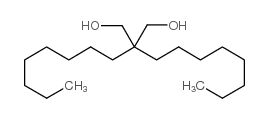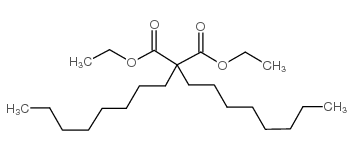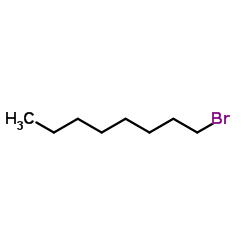106868-09-1
| 中文名 | 2,2-二辛基-1,3-丙二醇 |
|---|---|
| 英文名 | 2,2-dioctylpropane-1,3-diol |
| 中文别名 |
9,9-双(羟甲基)十七烷
2,2-二正辛基-1,3-丙二醇 1,3-二羟基-2,2-正辛基丙烷 |
| 英文别名 |
1,3-Dihydroxy-2,2-di-n-octylpropane
2,2-Di-n-octyl-1,3-propanediol 2,2-dioctylpropan-1,3-diol D2842 2,2-dioctyl-1,3-propanediol |
| 密度 | 0.891g/cm3 |
|---|---|
| 沸点 | 424.3ºC at 760 mmHg |
| 分子式 | C19H40O2 |
| 分子量 | 300.52000 |
| 闪点 | 180.9ºC |
| 精确质量 | 300.30300 |
| PSA | 40.46000 |
| LogP | 5.45860 |
| 外观性状 | 固体;White or Colorless to Almost white or Almost colorless powder to lump to clear liquid |
| 蒸汽压 | 5.62E-09mmHg at 25°C |
| 折射率 | 1.464 |
| 储存条件 | 0-10°C |
| 水溶解性 | 可溶于:甲醇 |
| 分子结构 | 1、摩尔折射率:93.1 2、摩尔体积(cm3/mol):337.2 3、等张比容(90.2K):816.6 4、表面张力(dyne/cm):34.3 5、介电常数:无可用的 6、极化率(10-24cm3):36.91 7、单一同位素质量:300.302831 Da 8、标称质量:300 Da 9、平均质量:300.5197 Da |
| 计算化学 | 1.疏水参数计算参考值(XlogP):7.3 2.氢键供体数量:2 3.氢键受体数量:2 4.可旋转化学键数量:16 5.互变异构体数量:无 6.拓扑分子极性表面积40.5 7.重原子数量:21 8.表面电荷:0 9.复杂度:182 10.同位素原子数量:0 11.确定原子立构中心数量:0 12.不确定原子立构中心数量:0 13.确定化学键立构中心数量:0 14.不确定化学键立构中心数量:0 15.共价键单元数量:1 |
|
Section I.Chemical Product and Company Identification Chemical Name 2,2-Di-n-octyl-1,3-propanediol Portland OR Synonym1,3-Propanediol, 2,2-dioctyl -(9CI) Chemical FormulaC19H40O2 CAS Number106868-09-1 Section II.Composition and Information on Ingredients Chemical NameCAS Number Percent (%)TLV/PELToxicology Data 2,2-Di-n-octyl-1,3-propanediol106868-09-1 Not available. Not available.Not available. Section III. Hazards Identification Acute Health EffectsNo specific information is available in our data base regarding the toxic effects of this material for humans. However, exposure to any chemical should be kept to a minimum. Skin and eye contact may result in irritation. May be harmful if inhaled or ingested. Always follow safe industrial hygiene practices and wear proper protective equipment when handling this compound. CARCINOGENIC EFFECTS : Not available. Chronic Health Effects MUTAGENIC EFFECTS : Not available. TERATOGENIC EFFECTS : Not available. DEVELOPMENTAL TOXICITY: Not available. Repeated or prolonged exposure to this compound is not known to aggravate existing medical conditions. Section IV.First Aid Measures Eye ContactCheck for and remove any contact lenses. In case of contact, immediately flush eyes with plenty of water for at least 15 minutes. Get medical attention. Skin ContactIn case of contact, immediately flush skin with plenty of water. Remove contaminated clothing and shoes. Wash clothing before reuse. Thoroughly clean shoes before reuse. Get medical attention. InhalationIf the victim is not breathing, perform mouth-to-mouth resuscitation. Loosen tight clothing such as a collar, tie, belt or waistband. If breathing is difficult, oxygen can be administered. Seek medical attention if respiration problems do not improve. IngestionINDUCE VOMITING by sticking finger in throat. Lower the head so that the vomit will not reenter the mouth and throat. Loosen tight clothing such as a collar, tie, belt or waistband. If the victim is not breathing, perform mouth-to-mouth resuscitation. Examine the lips and mouth to ascertain whether the tissues are damaged, a possible indication that the toxic material was ingested; the absence of such signs, however, is not conclusive. Section V.Fire and Explosion Data Auto-IgnitionNot available. FlammabilityMay be combustible at high temperature. Flammable Limits Flash PointsNot available. Not available. Combustion ProductsThese products are toxic carbon oxides (CO, CO 2). Fire Hazards Not available. Risks of explosion of the product in presence of mechanical impact: Not available. Explosion Hazards Risks of explosion of the product in presence of static discharge: Not available. Fire Fighting Media SMALL FIRE: Use DRY chemical powder. and InstructionsLARGE FIRE: Use water spray, fog or foam. DO NOT use water jet. Consult with local fire authorities before attempting large scale fire-fighting operations. Continued on Next Page 2,2-Di-n-octyl-1,3-propanediol Section VI.Accidental Release Measures Spill CleanupUse a shovel to put the material into a convenient waste disposal container. Finish cleaning the spill by rinsing any Instructionscontaminated surfaces with copious amounts of water. Consult federal, state, and/or local authorities for assistance on disposal. Section VII. Handling and Storage Handling and StorageKeep away from heat. Mechanical exhaust required. When not in use, tightly seal the container and store in a dry, cool place. Avoid excessive heat and light. Do not breathe dust. Information Always store away from incompatible compounds such as oxidizing agents. Section VIII. Exposure Controls/Personal Protection Engineering ControlsUse process enclosures, local exhaust ventilation, or other engineering controls to keep airborne levels below recommended exposure limits. If user operations generate dust, fume or mist, use ventilation to keep exposure to airborne contaminants below the exposure limit. Personal ProtectionSplash goggles. Lab coat. Dust respirator. Boots. Gloves. Suggested protective clothing might not be sufficient; consult a specialist BEFORE handling this product. Be sure to use a MSHA/NIOSH approved respirator or equivalent. Exposure LimitsNot available. Section IX. Physical and Chemical Properties Solid. (White Crystal Lumps.)Solubility Physical state @ 20°CSoluble in methanol. Not available. Specific Gravity Molecular Weight300.52Partition CoefficientNot available. Boiling Point Not available.Vapor PressureNot applicable. Melting Point36°C (96.8°F)Vapor DensityNot available. Refractive IndexNot available.VolatilityNot available. Critical TemperatureNot available.OdorNot available. ViscosityNot available.TasteNot available. Section X.Stability and Reactivity Data Stability This material is stable if stored under proper conditions. (See Section VII for instructions) Conditions of InstabilityAvoid excessive heat and light. Incompatibilities Reactive with oxidizing agents. Section XI. Toxicological Information RTECS NumberNot available. Eye Contact. Ingestion. Inhalation. Routes of Exposure Toxicity DataNot available. Chronic Toxic EffectsCARCINOGENIC EFFECTS : Not available. MUTAGENIC EFFECTS : Not available. TERATOGENIC EFFECTS : Not available. DEVELOPMENTAL TOXICITY: Not available. Repeated or prolonged exposure to this compound is not known to aggravate existing medical conditions. Acute Toxic EffectsNo specific information is available in our data base regarding the toxic effects of this material for humans. However, exposure to any chemical should be kept to a minimum. Skin and eye contact may result in irritation. May be harmful if inhaled or ingested. Always follow safe industrial hygiene practices and wear proper protective equipment when handling this compound. Continued on Next Page 2,2-Di-n-octyl-1,3-propanediol Section XII.Ecological Information EcotoxicityNot available. Environmental FateNot available. Section XIII. Disposal Considerations Recycle to process, if possible. Consult your local regional authorities. You may be able to dissolve or mix material with a Waste Disposal combustible solvent and burn in a chemical incinerator equipped with an afterburner and scrubber system. Observe all federal, state and local regulations when disposing of the substance. Section XIV. Transport Information DOT ClassificationNot a DOT controlled material (United States). PIN NumberNot applicable. Proper Shipping Name Not applicable. Packing Group (PG)Not applicable. DOT Pictograms Section XV. Other Regulatory Information and Pictograms TSCA Chemical InventoryThis product is NOT on the EPA Toxic Substances Control Act (TSCA) inventory. The following notices are required by 40 CFR 720.36 (C) for those products not on the inventory list: (EPA) (i) These products are supplied solely for use in research and development by or under the supervision of a technically qualified individual as defined in 40 CFR 720.0 et sec. (ii) The health risks of these products have not been fully determined. Any information that is or becomes available will be supplied on an MSDS sheet. WHMIS ClassificationNot available. (Canada) EINECS Number (EEC) Not available. EEC Risk StatementsNot available. SECTION 16 - ADDITIONAL INFORMATION N/A |
| 危险品运输编码 | 1325.0 |
|---|---|
| 危险类别 | 1.0 |
| 海关编码 | 2905399090 |
|
~69% 
106868-09-1 |
| 文献:Leznoff; Drew Canadian Journal of Chemistry, 1996 , vol. 74, # 3 p. 307 - 318 |
|
~% 
106868-09-1 |
| 文献:Journal of Organic Chemistry, , vol. 66, # 21 p. 6873 - 6882 |
| 上游产品 2 | |
|---|---|
| 下游产品 0 | |
| 海关编码 | 2905399090 |
|---|---|
| 中文概述 | 2905399090 其他二元醇。监管条件:AB(入境货物通关单,出境货物通关单)。增值税率:17.0%。退税率:9.0%。最惠国关税:5.5%。普通关税:30.0% |
| 申报要素 | 品名, 成分含量, 用途, 包装 |
| 监管条件 | A.入境货物通关单 B.出境货物通关单 |
| 检验检疫 | R.进口食品卫生监督检验 S.出口食品卫生监督检验 M.进口商品检验 N.出口商品检验 |
| Summary | 2905399090 other diols。supervision conditions:AB(certificate of inspection for goods inward,certificate of inspection for goods outward)。VAT:17.0%。tax rebate rate:9.0%。MFN tariff:5.5%。general tariff:30.0% |



